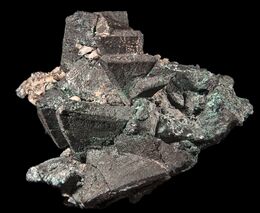تنانتيت Tennantite
| Tennantite | |
|---|---|
 | |
| العامة | |
| التصنيف | Sulfosalt minerals |
| الصيغة (repeating unit) | Cu 6[Cu 4(Fe,Zn) 2]As 4S 13[1] |
| تصنيف سترونز | 2.GB.05 |
| النظام البلوري | Cubic |
| Crystal class | Hextetrahedral (43m) H-M symbol: (4 3m) |
| Space group | I43m |
| التعرف | |
| Color | Flint-gray to iron-black, cherry-red in transmitted light |
| Crystal habit | massive to well formed crystals |
| Twinning | Contact and penetration twins |
| Cleavage | None |
| Fracture | Subconchoidal to uneven |
| Tenacity | Somewhat brittle |
| Mohs scale hardness | 3 – 4.5 |
| Luster | Metallic, commonly splendent |
| Streak | reddish gray |
| Diaphaneity | Opaque, except in very thin fragments |
| الجاذبية النوعية | 4.65 |
| Polish luster | gray, inclining to black to brown to cherry-red |
| الصفات البصرية | Isotropic |
| Refractive index | n greater than 2.72 |
| References | [1][2][3] |
تنانتيت Tennantite هو copper arsenic sulfosalt mineral with an ideal formula Cu
12As
4S
13. Due to variable substitution of the copper by iron and zinc the formula is Cu
6[Cu
4(Fe,Zn)
2]As
4S
13.[1] It is gray-black, steel-gray, iron-gray or black in color. A closely related mineral, tetrahedrite (Cu
12Sb
4S
13) has antimony substituting for arsenic and the two form a solid solution series. The two have very similar properties and is often difficult to distinguish between tennantite and tetrahedrite. Iron, zinc, and silver substitute up to about 15% for the copper site.[1][2]
The mineral was first described for an occurrence in Cornwall, England in 1819, where it occurs as small crystals of cubic or dodecahedral form, and was named after the English chemist Smithson Tennant (1761–1815).[1][4]

It is found in hydrothermal veins and contact metamorphic deposits in association with other Cu–Pb–Zn–Ag sulfides and sulfosalts, pyrite, calcite, dolomite, siderite, barite, fluorite and quartz.[2]
The arsenic component of tennantite causes the metal smelted from the ore to be harder than that of pure copper, because it is a copper-arsenic alloy. In the later 20th century, it was found that arsenical coppers had been more widely used in antiquity than had been previously realised, and it has been proposed that discoveries made by smelting ores like tennantite were significant steps in the progress towards the Bronze Age.[5]
انظر أيضاً
References
- ^ أ ب ت ث ج Mindat.org
- ^ أ ب ت Handbook of Mineralogy
- ^ Webmineral data
- ^
 Spencer, Leonard James (1911). . In Chisholm, Hugh (ed.). دائرة المعارف البريطانية. Vol. 26 (eleventh ed.). Cambridge University Press. pp. 670–671.
Spencer, Leonard James (1911). . In Chisholm, Hugh (ed.). دائرة المعارف البريطانية. Vol. 26 (eleventh ed.). Cambridge University Press. pp. 670–671. {{cite encyclopedia}}: Cite has empty unknown parameter:|coauthors=(help) - ^ Penhallurick, R.D. (1986), Tin in Antiquity: its mining and trade throughout the ancient world with particular reference to Cornwall, London: The Institute of Metals, p. 4, ISBN 0-904357-81-3